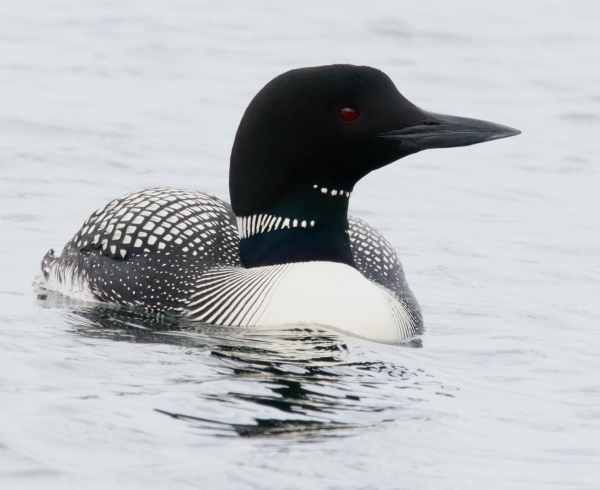
This was my earliest “summer” visit to check on territorial Common Loons in west-central Minnesota.
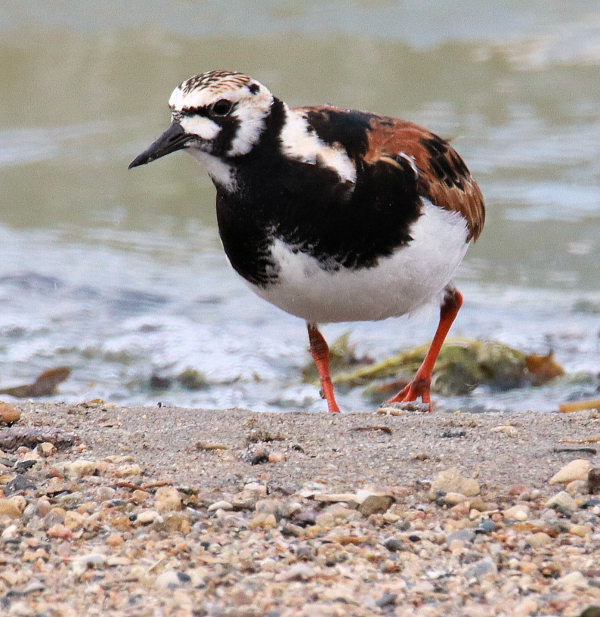
Ruddy Turnstones continued their migration stopover at Carlson Lake last Tuesday.
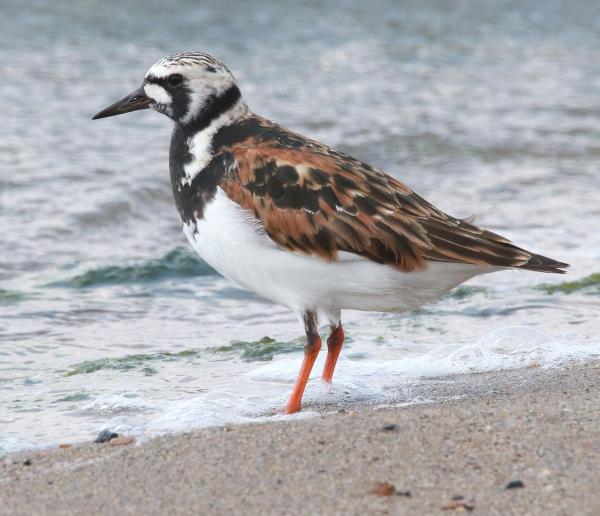
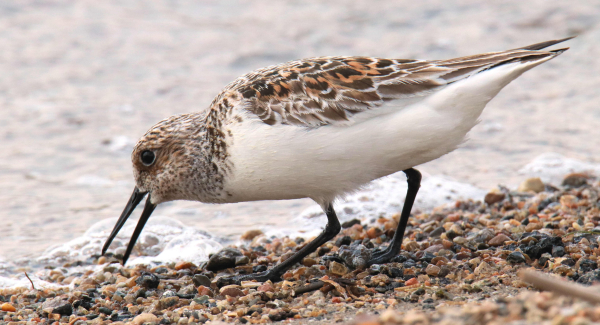
These 3 photographs of Sanderlings on their way to high Arctic nesting areas reveal different stages of molting between their winter (basic) and alternate plumages.
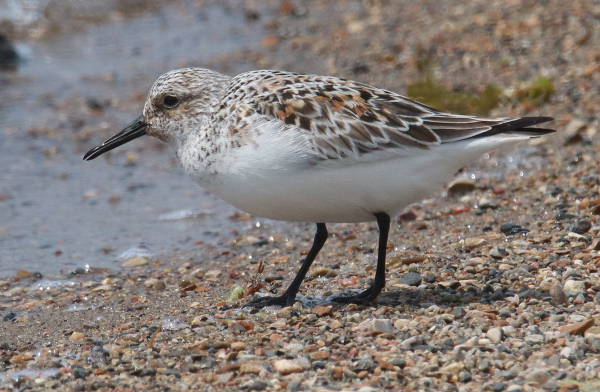

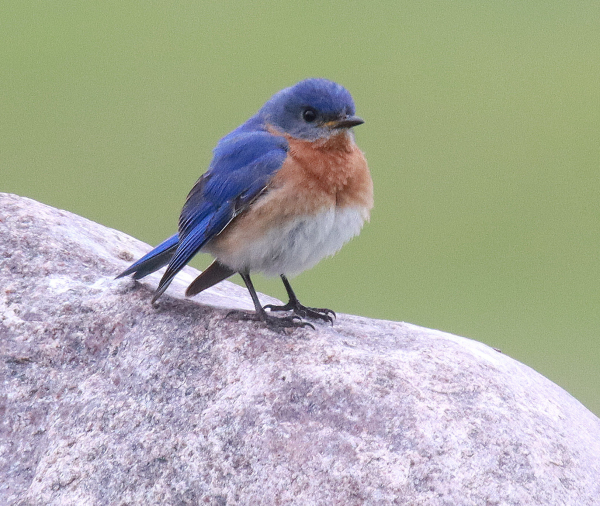
The chance to photograph a beautiful male Eastern Bluebird provided a crowning touch to an energizing circle trip to Minnesota and back to Dakota – birding all the way.
|
It was an exciting week filled with birds I don’t normally see in the Great Plains the first week of June, ranging from Trumpeter Swans to Wood Ducks, Common Loons, Ospreys, Bald Eagles, Ruddy Turnstones, Sanderlings, an American Redstart, and almost a Pileated Woodpecker. These and many more birds were sighted along a big circle tour I took from rural south-central North Dakota to the mega-city of Minneapolis in southeast Minnesota, then north to the Pelican Lakes area near DL (Detroit Lakes, Minnesota) and home again via Fargo and Jamestown, where I photographed a male Eastern Bluebird displaying – all in just 3 days.
Covering a lot of landscape, I enjoyed the variety of birds, and photographed several species, including some interesting surprises along the way. Before I began my big drive southeast, I wanted to check on Carlson Lake, just in case the Ruddy Turnstones I found the previous day were still around. A north wind was pushing waves across the big lake, so I didn’t think the turnstones would be on the southeast side again, especially when I saw how the offshore water was muddied up from the wave action. So as I passed over the lake hill I was a bit surprised to see the shoreline was alive with many different shorebirds, including Ruddy Turnstones.
You may remember that the previous day there was a lone Sanderling among the 35ish turnstones, the first Sanderling I’ve seen beyond ocean coasts during winter. Very few are known to migrate through the center of the continent, but Tuesday there were about 45 Sanderlings – quite an increase over the previous day’s first of state sighting! The single Sanderling seemed like a rare bird sighting, but with a flock of Sanderlings before me I was especially excited. Now though, I had a second chance to photograph them.
I took a few photos of the furiously feeding shorebird group from the road, then parked and walked down the hill, using a stand of willows near the shore for cover. Then I poked my head and camera out of the willows to photograph the active birds – Sanderlings, Ruddy Turnstones, Semipalmated Sandpipers (all Arctic nesters), plus 4 local American Avocets, a Willet, and a few Wilson’s Phalaropes. Even though I was quite close to the birds as I stood among the willows, none of the birds flushed, and some foraged much closer, within 15 feet at times, which was quite a thrill. But wait, I needed to get on the road toward Minneapolis.
Not far to the south of home, a migrating flock of 11 Common Nighthawks was foraging low in the sky immediately south of Charo Marsh, and there was an abundance of ducks on my way south and east. Not far into Minnesota, Trumpeter Swans began appearing, with groups numbering 2, 5, 1, and 4. Before I visited my family north of Minneapolis – Anders, Katy, and Jeff – I stopped at a small lake that Katy told me about several years ago when I was interested in photographing Wood Ducks. Indeed, there was a healthy population of Wood Ducks and Mallards, now represented by 16 males and a single female; other females were undoubtedly incubating their clutch of eggs in a nearby nest box or natural cavity. There were even more male Mallards, a couple hen Mallards, and a lone female Hooded Merganser. It was fun to photograph the Wood Ducks and Hoody, and by the way, some of the Woodys and Mallards were already molting.
Next stop was my friend Andy’s home on Little Pelican Lake, where we planned to photograph Common Loons the next morning. After a light morning rainfall, we circled the lake on the first loon adventure of the year, during which I theorized pairs of loons should be in the early stage of incubating eggs, based on previous year’s observations there. Last year we observed the earliest downy hatchling the last week of June, earlier than any other year. At the end of our circle tour of the lake, we found a lone adult, which made sense; the other adult in the pair should be incubating. We photographed the elegant waterbird from the loon pontoon, and Andy suggested we should advance to big Pelican Lake, via the connecting river.
As we entered the big lake I noticed something kinda big on the water’s surface from a distance. It seemed too big to be a loon, but maybe it was 2. As we approached, we were really surprised to see an adult with 2 newly hatched young (on June 5th)! That meant the pair began nesting about the first of May considering the 27-day incubation period – very surprising! We were especially careful not to get too close, and as soon as we turned the motor off the young loons began napping near the beautiful adult. A couple minutes later, a hatchling approached the adult and moments later Andy saw the other adult approaching.
The presumed male dived and swam underwater most of the way to join the family group, and his appearance also seemed to prompt a slow move closer to shore. In the process, they swam very close to the loon pontoon, giving us excellent views of the downy hatchlings and the adults. It was exciting to have the loon family before us, seemingly unconcerned with the floating boat, and we didn’t persist long, wanting to leave the surprise hatchlings in peace with the adults. Loons are such noble birds and they show that so well when they grace northern lakes in full color.
We headed back to Andy’s dock, surprised to see the earliest hatchlings in the area, and happy to see the first “twins” since we began photographing on these lakes. (You can see more photographs in this issue’s Bird Photography feature.) During our cruise, we observed a couple Great Blue Herons, a Belted Kingfisher, Cliff Swallows and Tree Swallows, a Wood Duck, and an Osprey that flew over just as we began photographing the first loon. Back on shore, Andy was showing me where an apparent Pileated Woodpecker had been working on oblong cavity it enlarged one of his trees. Just then, a loud hollow pecking sound emanated from high in a big oak tree in front of us.
Excited, I wanted to try to see the big woodpecker, camera in hand, and worked my way around to the river side of the tall tree. I was in the best possible place, but the Pileated never showed itself – nice try though. As I was positioning toward the oak tree, I was surprised by a male American Redstart that dived to the ground a few feet from my toes to grab a bug on the ground, perhaps one that I startled. This was most likely a territorial redstart rather than a late migrant, considering that I always see American Redstarts along the edges of Andy’s woods and open yardscape during summer visits. There were Gray Catbirds and American Robins on hand, and Andy has Baltimore Orioles and Ruby-throated Hummingbirds visiting the feeders on his second-floor deck occasionally.
In southwest Fargo, my 3 nephews and 2 nieces were keenly aware of the birds as we played in their yard and checked out a bird book with bird songs and an archeology book on the deck. Even little Ruby, who is little more than a year old was pointing at birds that flew by. Mama Krista pointed out a pair of Gray Partridges in an open area close to their yard that everyone enjoyed seeing close to home too. On my way back to my home I stopped at Northern Prairie Wildlife Research Center near Jamestown with the hope finding the bluebirds that used one of the nest boxes near the administration building last year. An earlier nest check didn’t produce any bluebird sightings, and after monitoring the nest boxes for a bit with no luck, as I was leaving a male Eastern Bluebird was evident as it displayed on the top of a boulder near the center’s entrance – a nice exclamation point to an action-packed trip the first week of June.
At home, the identifiable ‘yellow-orange’-and-black male Baltimore Oriole made regular visits most days, as did male and female Orchard Orioles, Gray Catbirds, House Finches, and American Robins. After I returned from my trip, a female Ruby-throated Hummingbird was a regular visitor Friday and Saturday, but no hummers were sighted Sunday. A fine male stopped in Monday morning, and a male and female were seen later.
Throughout June, continue to enjoy the action in your yard, at your feeders, at local hotspots and favorite birding sites, and I encourage you to look beyond the norm too – there are probably new hotspots for you to seek out nearby. Enjoy your June birding opportunities and avian encounters!
Article and Photos by Paul Konrad
Share your bird sightings and photographs at editorstbw2@gmail.com